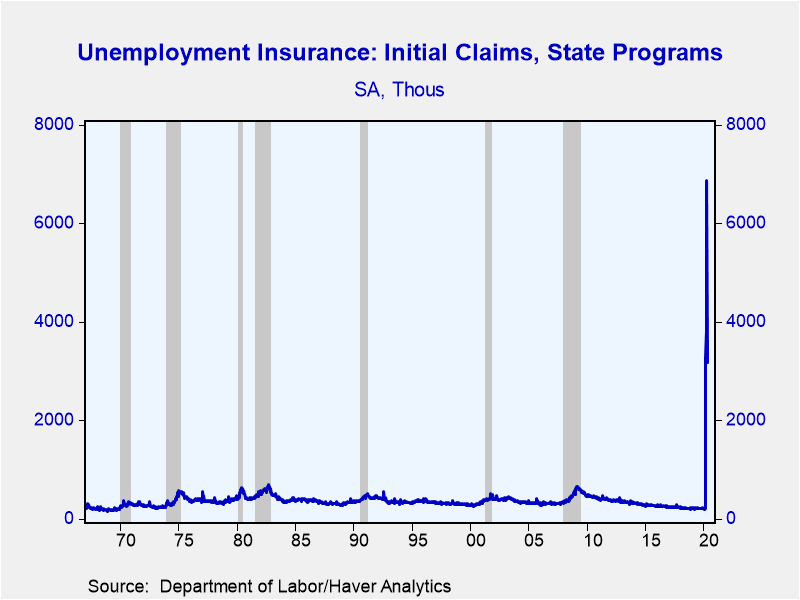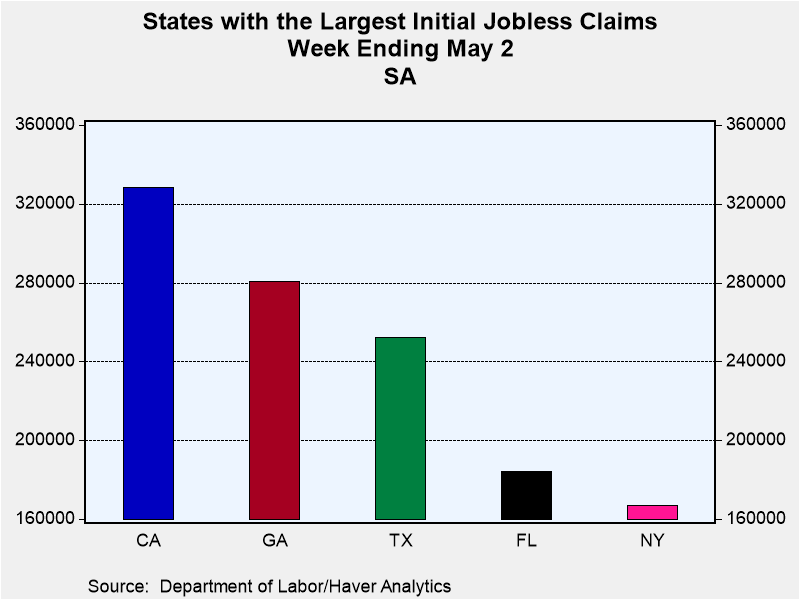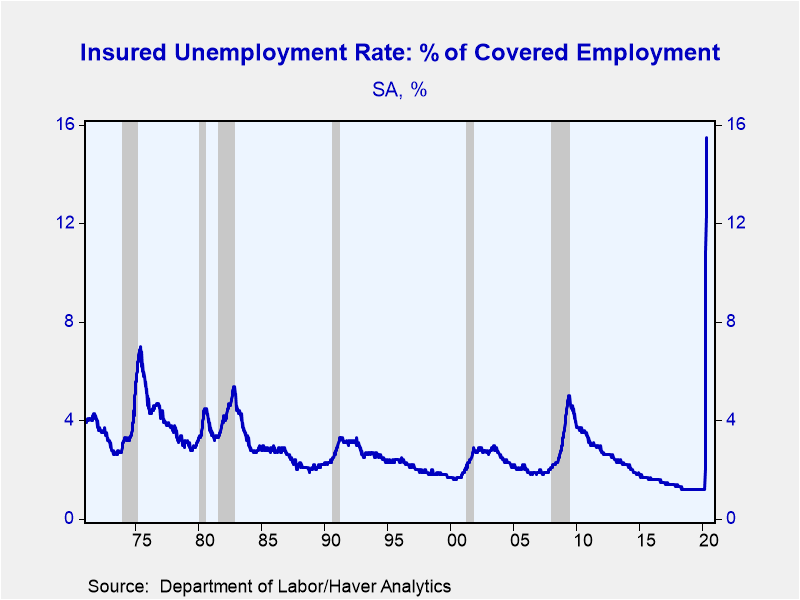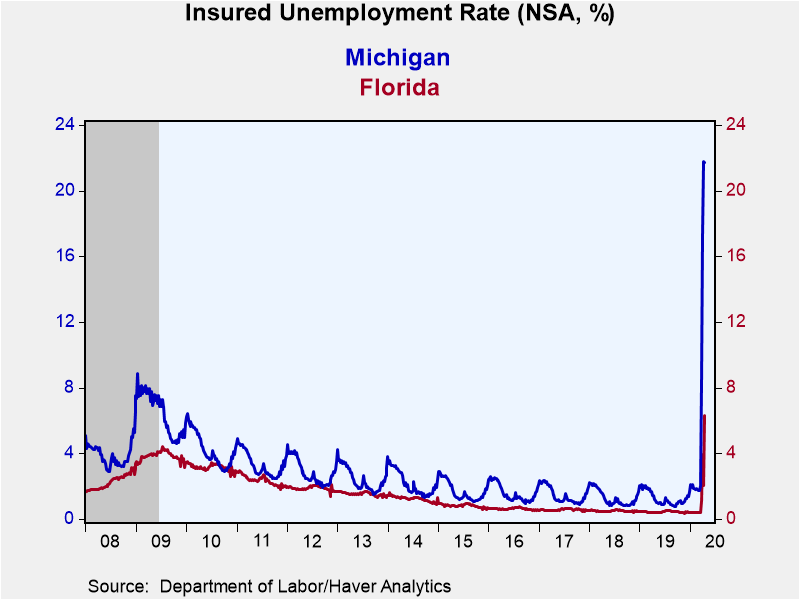 Global| May 07 2020
Global| May 07 2020State Initial Jobless Claims Top 33 Million in Last Seven Weeks: New Data on Pandemic Unemployment Assistance Program
Summary
• Initial jobless claims declined to a still extremely-elevated 3.169 million in the week ending May 2. • Over the last seven weeks 33.5 million people or 20.6% of the labor force have filed new claims. • New data on the federal [...]
• Initial jobless claims declined to a still extremely-elevated 3.169 million in the week ending May 2.
• Over the last seven weeks 33.5 million people or 20.6% of the labor force have filed new claims.
• New data on the federal Pandemic Unemployment Assistance program show over 1.5 million new filers.
• Ten states had over 100,000 new claims, led by California's 328,375.
Initial jobless claims for unemployment insurance decreased to 3.169 million during the week ending May 2 from a slightly upwardly-revised 3.846 million in the previous week (was 3.839 million). During the last seven weeks 33.5 million people or 20.6% of the labor force have filed new jobless claims. The Action Economics Forecast Survey anticipated 3 million claims.
The four-week moving average of initial claims, which smooths out week-to-week volatility, but is less important at the moment because of the rapidity of changing conditions, declined to 4.174 million from 5.035 million.
This week's report by the Department of Labor introduced data on the federal Pandemic Unemployment Assistance (PUA) program, which covers individuals such as the self-employed who are not qualified for regular/state unemployment insurance. In the week ending May 2, there were 583,699 new claims, following 780,866 in the previous week. In the week ending April 18, continuing PUA claims totaled 994,850. The report also provided new data on continuing claims filed under the Pandemic Emergency Unemployment Compensation (PEUC) program, which extends benefits for an additional 13 weeks. In the week ending April 18, 52,305 filed for continuing claims under this program. Data for these federal programs are not seasonally adjusted.
Ten states had over 100,000 in new claims in the week ending May 2, led by California (328,375), Georgia (280,936), and Texas (252,430). Claims increased the most in New Jersey (35,781 or 50.6% week-on-week) and Maryland (32,398 or 68.6% w/w) and decreased the most in Florida (-302,291 or -62.1% w/w) and Georgia (-68,749 or -19.7% w/w). The state numbers are based on seasonally-adjusted data calculated by Haver Analytics. The Department of Labor notes that advance claims are not directly comparable to claims reported in prior weeks and a number of states indicated these numbers are only estimates. A more accurate picture of state claims in the week ending May 2 will be available next week.
Continuing claims for unemployment insurance increased to a record 22.647 million in the week ending April 25, from an upwardly-revised 18.011 million (was 17.992 million). The insured rate of unemployment jumped to a new high of 15.5% (data goes back to 1971). The state insured rates of unemployment continued to show wide variation with South Dakota at just 5.4% and Vermont at 25.2%. Thirty-two states had rates over 10%, and four states were over 20%. The state rates are not seasonally adjusted.
Data on weekly unemployment claims going back to 1967 are contained in Haver's WEEKLY database, and they are summarized monthly in USECON. Data for individual states are in REGIONW. The expectations figure is from the Action Economics Forecast Survey, carried in the AS1REPNA database.
| Unemployment Insurance (SA, 000s) | 05/02/20 | 04/25/20 | 04/18/20 | Y/Y % | 2019 | 2018 | 2017 |
|---|---|---|---|---|---|---|---|
| Initial Claims | 3,169 | 3,846 | 4,442 | 1,308.4 | 218 | 221 | 244 |
| 4-wk Average | 4,173.50 | 5,035.00 | 5,790.25 | -- | -- | -- | -- |
| Initial Claims Pandemic Unemployment Assistance (NSA) | 584 | 781 | 219 | -- | -- | -- | -- |
| Continuing Claims | -- | 22,647 | 18,011 | 1,244.8 | 1,701 | 1,756 | 1,961 |
| 4-week Average | -- | 17,097.75 | 13,297.50 | -- | -- | -- | -- |
| Continuing Claims Pandemic Unemployment Assistance (NSA) | -- | -- | 995 | -- | -- | -- | -- |
| Insured Unemployment Rate (%) | -- | 15.5 | 12.4 |
1.2 |
1.2 | 1.2 | 1.4 |
Gerald D. Cohen
AuthorMore in Author Profile »Gerald Cohen provides strategic vision and leadership of the translational economic research and policy initiatives at the Kenan Institute of Private Enterprise.
He has worked in both the public and private sectors focusing on the intersection between financial markets and economic fundamentals. He was a Senior Economist at Haver Analytics from January 2019 to February 2021. During the Obama Administration Gerald was Deputy Assistant Secretary for Macroeconomic Analysis at the U.S. Department of Treasury where he helped formulate and evaluate the impact of policy proposals on the U.S. economy. Prior to Treasury, he co-managed a global macro fund at Ziff Brothers Investments.
Gerald holds a bachelor’s of science from the Massachusetts Institute of Technology and a Ph.D. in Economics from Harvard University and is a contributing author to 30-Second Money as well as a co-author of Political Cycles and the Macroeconomy.









